Report on the Impact of Increasing Commute Times on Employees
VerifiedAdded on 2022/08/25
|9
|1508
|19
Report
AI Summary
This report examines the growing issue of increasing commute times for employees in Australia, highlighting its significant negative impacts. It begins with an introduction that sets the stage for the analysis. The discussion section employs a PESTLE analysis to evaluate the political, economic, social, technological, legal, and environmental factors contributing to the problem. The report then delves into the effects on job satisfaction, decreased productivity, and negative impacts beyond work, such as stress and lack of time for personal activities. The report also considers the environmental consequences of increased commute times, including pollution and congestion. The report concludes with recommendations for organizations and the government to mitigate the negative impacts of long commutes, such as remote work options, flexible hours, and improved public transport. The references section lists all the sources used for the report.
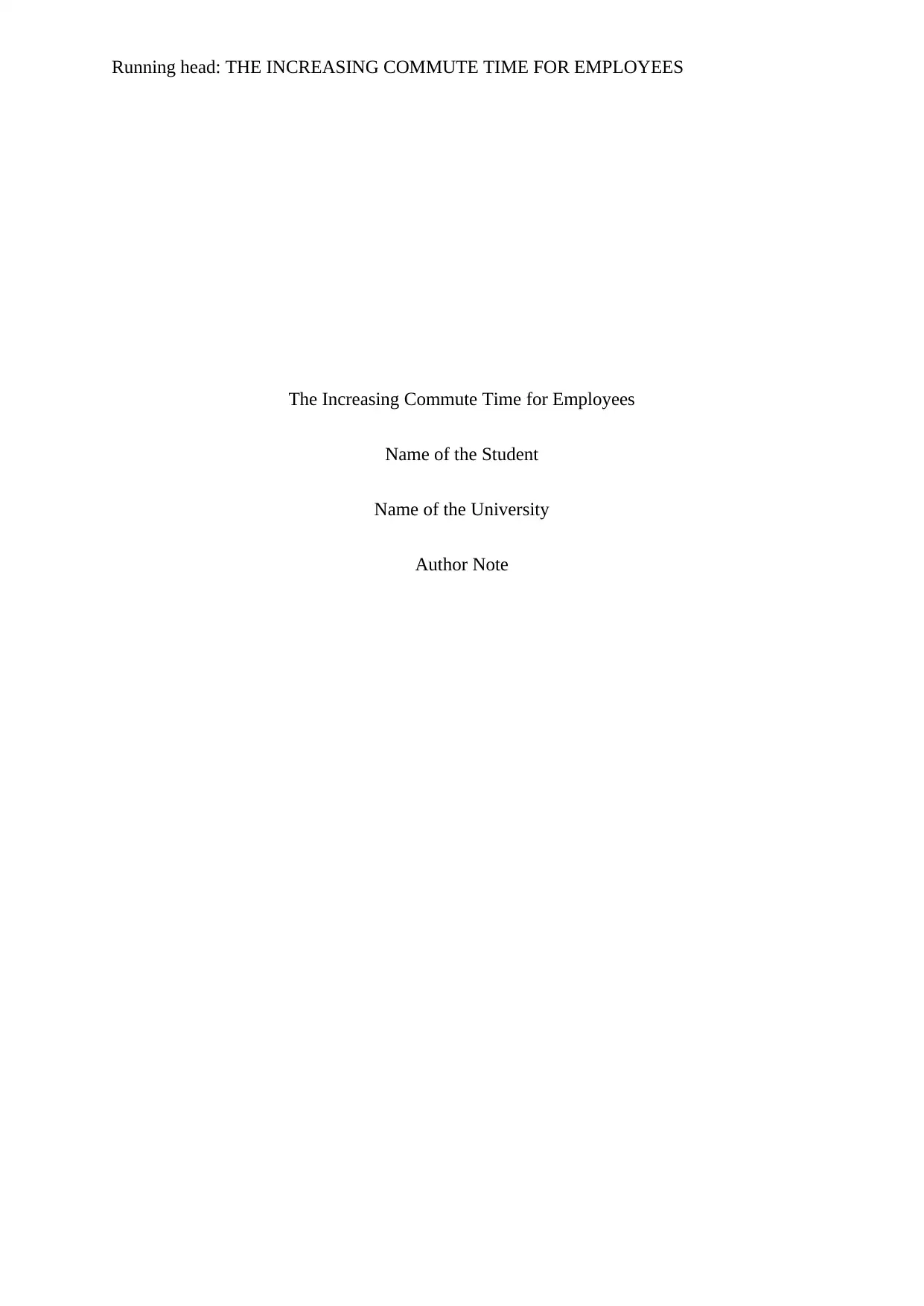
Running head: THE INCREASING COMMUTE TIME FOR EMPLOYEES
The Increasing Commute Time for Employees
Name of the Student
Name of the University
Author Note
The Increasing Commute Time for Employees
Name of the Student
Name of the University
Author Note
Paraphrase This Document
Need a fresh take? Get an instant paraphrase of this document with our AI Paraphraser
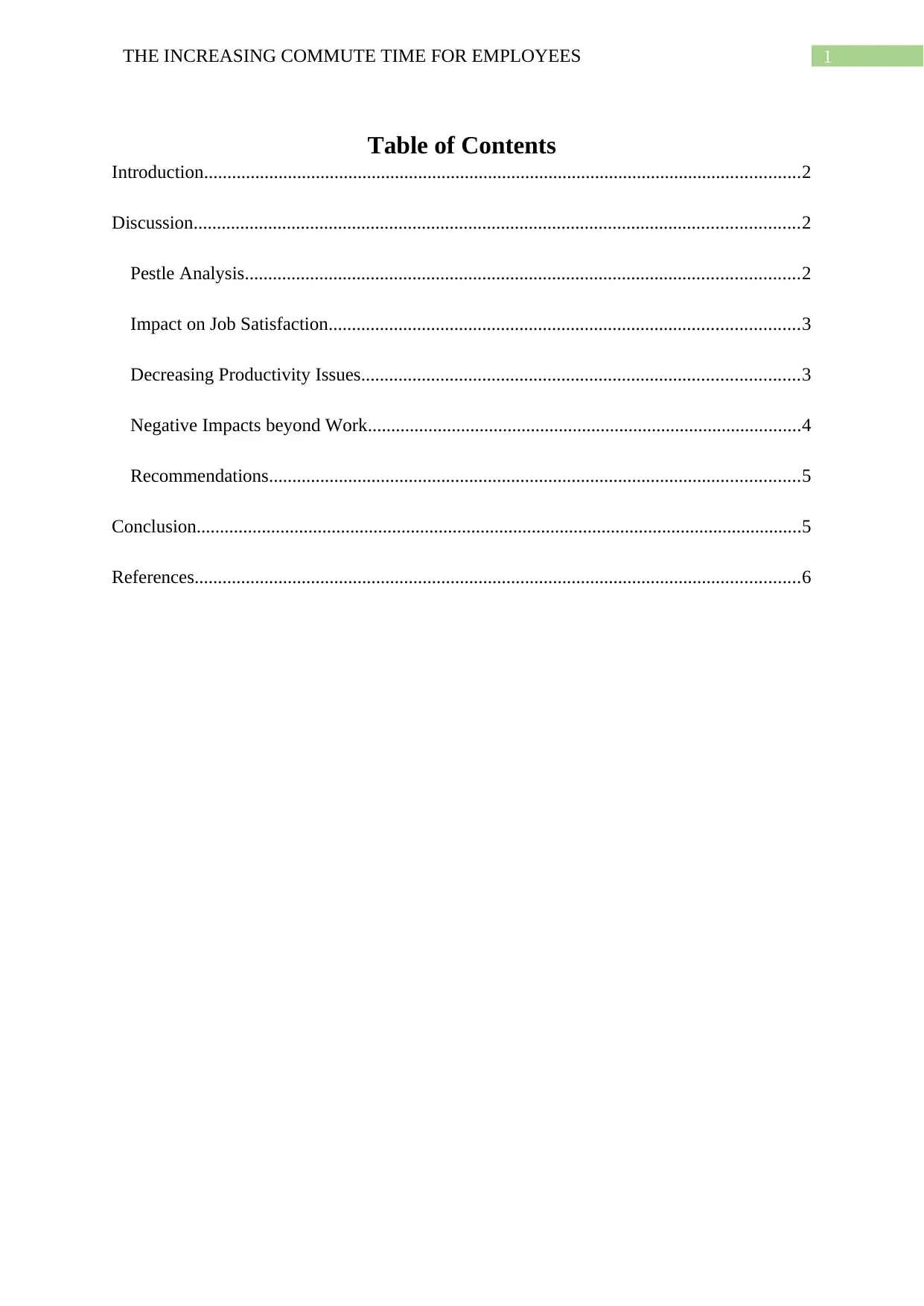
1THE INCREASING COMMUTE TIME FOR EMPLOYEES
Table of Contents
Introduction................................................................................................................................2
Discussion..................................................................................................................................2
Pestle Analysis.......................................................................................................................2
Impact on Job Satisfaction.....................................................................................................3
Decreasing Productivity Issues..............................................................................................3
Negative Impacts beyond Work.............................................................................................4
Recommendations..................................................................................................................5
Conclusion..................................................................................................................................5
References..................................................................................................................................6
Table of Contents
Introduction................................................................................................................................2
Discussion..................................................................................................................................2
Pestle Analysis.......................................................................................................................2
Impact on Job Satisfaction.....................................................................................................3
Decreasing Productivity Issues..............................................................................................3
Negative Impacts beyond Work.............................................................................................4
Recommendations..................................................................................................................5
Conclusion..................................................................................................................................5
References..................................................................................................................................6
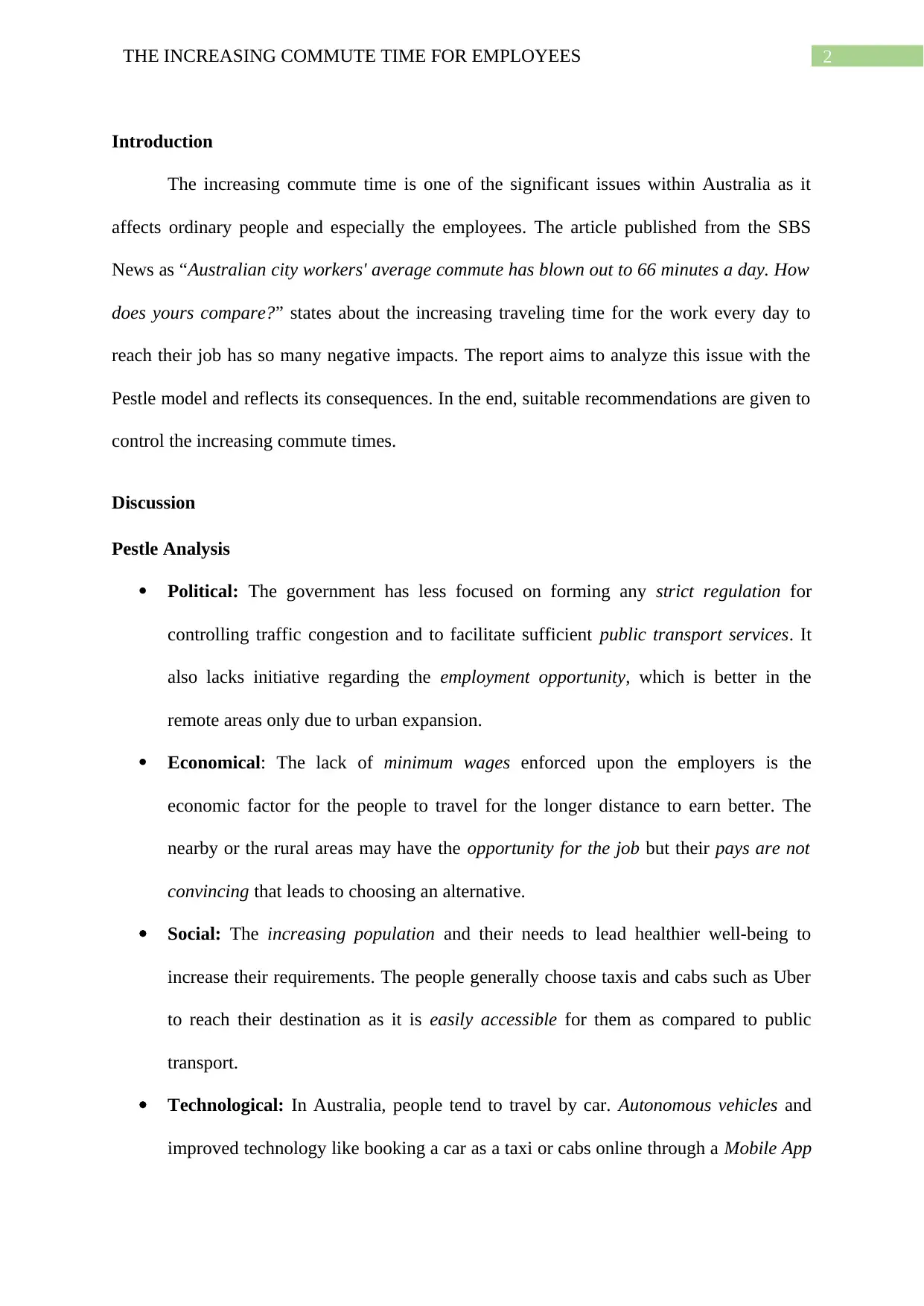
2THE INCREASING COMMUTE TIME FOR EMPLOYEES
Introduction
The increasing commute time is one of the significant issues within Australia as it
affects ordinary people and especially the employees. The article published from the SBS
News as “Australian city workers' average commute has blown out to 66 minutes a day. How
does yours compare?” states about the increasing traveling time for the work every day to
reach their job has so many negative impacts. The report aims to analyze this issue with the
Pestle model and reflects its consequences. In the end, suitable recommendations are given to
control the increasing commute times.
Discussion
Pestle Analysis
Political: The government has less focused on forming any strict regulation for
controlling traffic congestion and to facilitate sufficient public transport services. It
also lacks initiative regarding the employment opportunity, which is better in the
remote areas only due to urban expansion.
Economical: The lack of minimum wages enforced upon the employers is the
economic factor for the people to travel for the longer distance to earn better. The
nearby or the rural areas may have the opportunity for the job but their pays are not
convincing that leads to choosing an alternative.
Social: The increasing population and their needs to lead healthier well-being to
increase their requirements. The people generally choose taxis and cabs such as Uber
to reach their destination as it is easily accessible for them as compared to public
transport.
Technological: In Australia, people tend to travel by car. Autonomous vehicles and
improved technology like booking a car as a taxi or cabs online through a Mobile App
Introduction
The increasing commute time is one of the significant issues within Australia as it
affects ordinary people and especially the employees. The article published from the SBS
News as “Australian city workers' average commute has blown out to 66 minutes a day. How
does yours compare?” states about the increasing traveling time for the work every day to
reach their job has so many negative impacts. The report aims to analyze this issue with the
Pestle model and reflects its consequences. In the end, suitable recommendations are given to
control the increasing commute times.
Discussion
Pestle Analysis
Political: The government has less focused on forming any strict regulation for
controlling traffic congestion and to facilitate sufficient public transport services. It
also lacks initiative regarding the employment opportunity, which is better in the
remote areas only due to urban expansion.
Economical: The lack of minimum wages enforced upon the employers is the
economic factor for the people to travel for the longer distance to earn better. The
nearby or the rural areas may have the opportunity for the job but their pays are not
convincing that leads to choosing an alternative.
Social: The increasing population and their needs to lead healthier well-being to
increase their requirements. The people generally choose taxis and cabs such as Uber
to reach their destination as it is easily accessible for them as compared to public
transport.
Technological: In Australia, people tend to travel by car. Autonomous vehicles and
improved technology like booking a car as a taxi or cabs online through a Mobile App
⊘ This is a preview!⊘
Do you want full access?
Subscribe today to unlock all pages.

Trusted by 1+ million students worldwide
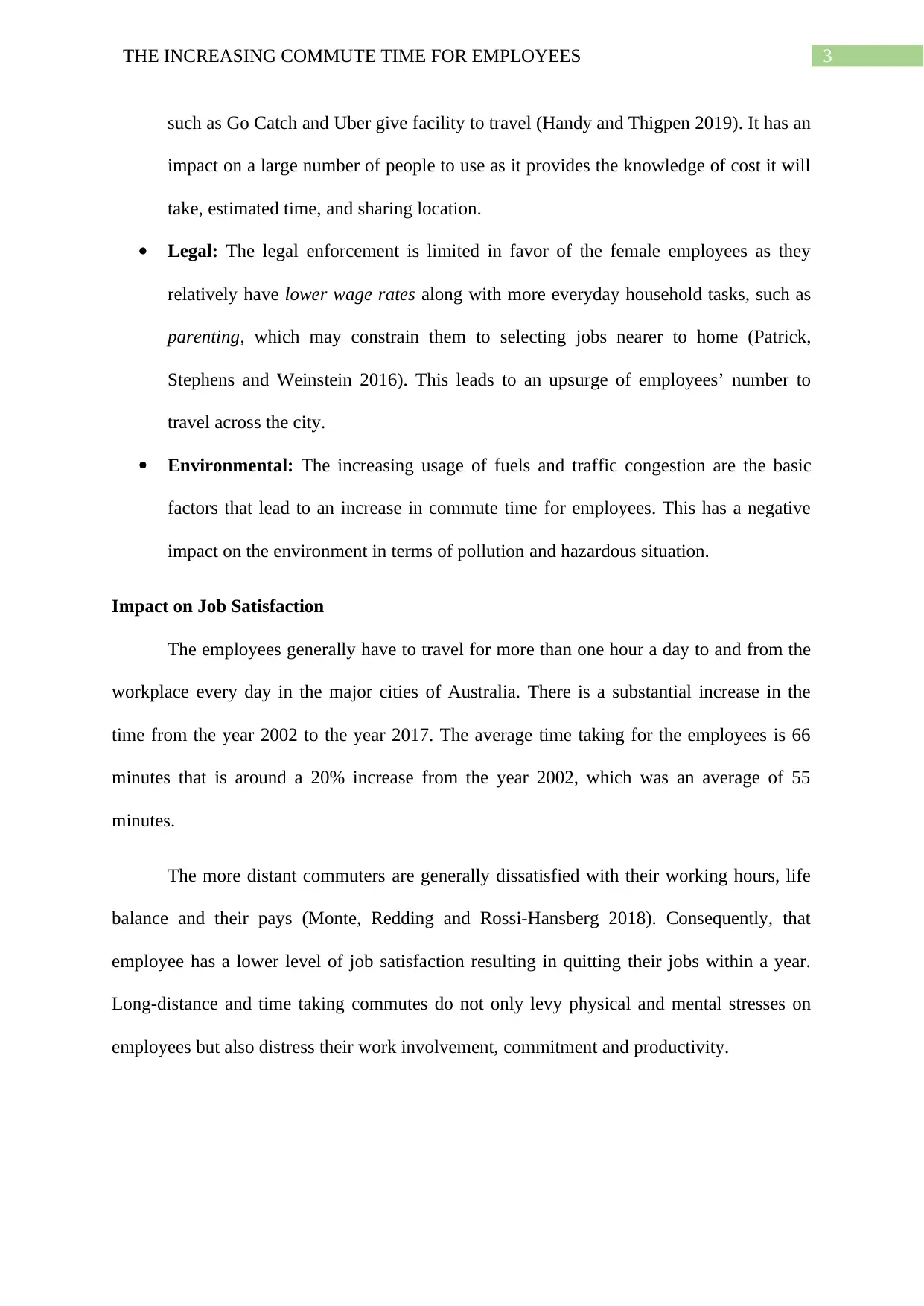
3THE INCREASING COMMUTE TIME FOR EMPLOYEES
such as Go Catch and Uber give facility to travel (Handy and Thigpen 2019). It has an
impact on a large number of people to use as it provides the knowledge of cost it will
take, estimated time, and sharing location.
Legal: The legal enforcement is limited in favor of the female employees as they
relatively have lower wage rates along with more everyday household tasks, such as
parenting, which may constrain them to selecting jobs nearer to home (Patrick,
Stephens and Weinstein 2016). This leads to an upsurge of employees’ number to
travel across the city.
Environmental: The increasing usage of fuels and traffic congestion are the basic
factors that lead to an increase in commute time for employees. This has a negative
impact on the environment in terms of pollution and hazardous situation.
Impact on Job Satisfaction
The employees generally have to travel for more than one hour a day to and from the
workplace every day in the major cities of Australia. There is a substantial increase in the
time from the year 2002 to the year 2017. The average time taking for the employees is 66
minutes that is around a 20% increase from the year 2002, which was an average of 55
minutes.
The more distant commuters are generally dissatisfied with their working hours, life
balance and their pays (Monte, Redding and Rossi-Hansberg 2018). Consequently, that
employee has a lower level of job satisfaction resulting in quitting their jobs within a year.
Long-distance and time taking commutes do not only levy physical and mental stresses on
employees but also distress their work involvement, commitment and productivity.
such as Go Catch and Uber give facility to travel (Handy and Thigpen 2019). It has an
impact on a large number of people to use as it provides the knowledge of cost it will
take, estimated time, and sharing location.
Legal: The legal enforcement is limited in favor of the female employees as they
relatively have lower wage rates along with more everyday household tasks, such as
parenting, which may constrain them to selecting jobs nearer to home (Patrick,
Stephens and Weinstein 2016). This leads to an upsurge of employees’ number to
travel across the city.
Environmental: The increasing usage of fuels and traffic congestion are the basic
factors that lead to an increase in commute time for employees. This has a negative
impact on the environment in terms of pollution and hazardous situation.
Impact on Job Satisfaction
The employees generally have to travel for more than one hour a day to and from the
workplace every day in the major cities of Australia. There is a substantial increase in the
time from the year 2002 to the year 2017. The average time taking for the employees is 66
minutes that is around a 20% increase from the year 2002, which was an average of 55
minutes.
The more distant commuters are generally dissatisfied with their working hours, life
balance and their pays (Monte, Redding and Rossi-Hansberg 2018). Consequently, that
employee has a lower level of job satisfaction resulting in quitting their jobs within a year.
Long-distance and time taking commutes do not only levy physical and mental stresses on
employees but also distress their work involvement, commitment and productivity.
Paraphrase This Document
Need a fresh take? Get an instant paraphrase of this document with our AI Paraphraser
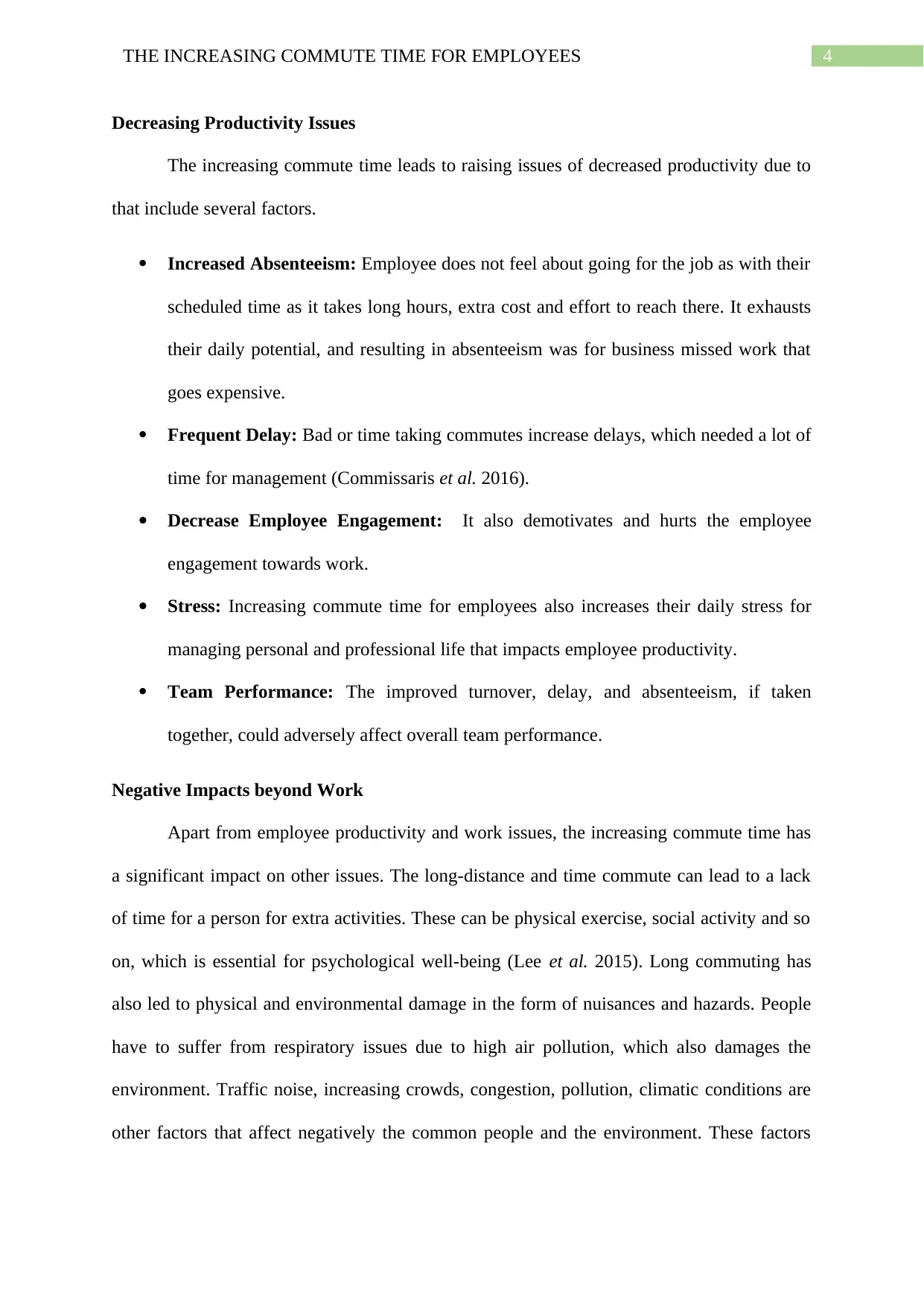
4THE INCREASING COMMUTE TIME FOR EMPLOYEES
Decreasing Productivity Issues
The increasing commute time leads to raising issues of decreased productivity due to
that include several factors.
Increased Absenteeism: Employee does not feel about going for the job as with their
scheduled time as it takes long hours, extra cost and effort to reach there. It exhausts
their daily potential, and resulting in absenteeism was for business missed work that
goes expensive.
Frequent Delay: Bad or time taking commutes increase delays, which needed a lot of
time for management (Commissaris et al. 2016).
Decrease Employee Engagement: It also demotivates and hurts the employee
engagement towards work.
Stress: Increasing commute time for employees also increases their daily stress for
managing personal and professional life that impacts employee productivity.
Team Performance: The improved turnover, delay, and absenteeism, if taken
together, could adversely affect overall team performance.
Negative Impacts beyond Work
Apart from employee productivity and work issues, the increasing commute time has
a significant impact on other issues. The long-distance and time commute can lead to a lack
of time for a person for extra activities. These can be physical exercise, social activity and so
on, which is essential for psychological well-being (Lee et al. 2015). Long commuting has
also led to physical and environmental damage in the form of nuisances and hazards. People
have to suffer from respiratory issues due to high air pollution, which also damages the
environment. Traffic noise, increasing crowds, congestion, pollution, climatic conditions are
other factors that affect negatively the common people and the environment. These factors
Decreasing Productivity Issues
The increasing commute time leads to raising issues of decreased productivity due to
that include several factors.
Increased Absenteeism: Employee does not feel about going for the job as with their
scheduled time as it takes long hours, extra cost and effort to reach there. It exhausts
their daily potential, and resulting in absenteeism was for business missed work that
goes expensive.
Frequent Delay: Bad or time taking commutes increase delays, which needed a lot of
time for management (Commissaris et al. 2016).
Decrease Employee Engagement: It also demotivates and hurts the employee
engagement towards work.
Stress: Increasing commute time for employees also increases their daily stress for
managing personal and professional life that impacts employee productivity.
Team Performance: The improved turnover, delay, and absenteeism, if taken
together, could adversely affect overall team performance.
Negative Impacts beyond Work
Apart from employee productivity and work issues, the increasing commute time has
a significant impact on other issues. The long-distance and time commute can lead to a lack
of time for a person for extra activities. These can be physical exercise, social activity and so
on, which is essential for psychological well-being (Lee et al. 2015). Long commuting has
also led to physical and environmental damage in the form of nuisances and hazards. People
have to suffer from respiratory issues due to high air pollution, which also damages the
environment. Traffic noise, increasing crowds, congestion, pollution, climatic conditions are
other factors that affect negatively the common people and the environment. These factors
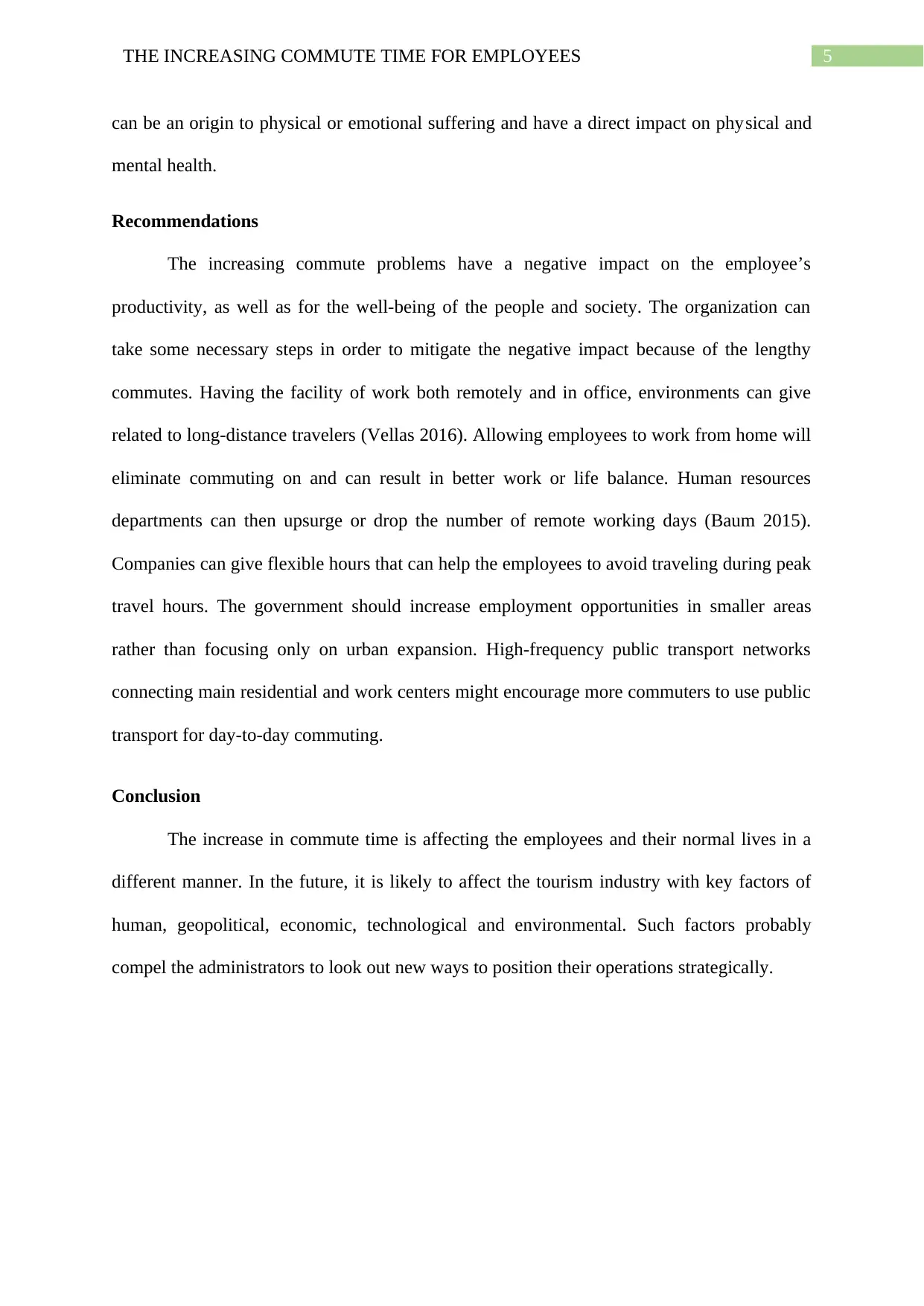
5THE INCREASING COMMUTE TIME FOR EMPLOYEES
can be an origin to physical or emotional suffering and have a direct impact on physical and
mental health.
Recommendations
The increasing commute problems have a negative impact on the employee’s
productivity, as well as for the well-being of the people and society. The organization can
take some necessary steps in order to mitigate the negative impact because of the lengthy
commutes. Having the facility of work both remotely and in office, environments can give
related to long-distance travelers (Vellas 2016). Allowing employees to work from home will
eliminate commuting on and can result in better work or life balance. Human resources
departments can then upsurge or drop the number of remote working days (Baum 2015).
Companies can give flexible hours that can help the employees to avoid traveling during peak
travel hours. The government should increase employment opportunities in smaller areas
rather than focusing only on urban expansion. High-frequency public transport networks
connecting main residential and work centers might encourage more commuters to use public
transport for day-to-day commuting.
Conclusion
The increase in commute time is affecting the employees and their normal lives in a
different manner. In the future, it is likely to affect the tourism industry with key factors of
human, geopolitical, economic, technological and environmental. Such factors probably
compel the administrators to look out new ways to position their operations strategically.
can be an origin to physical or emotional suffering and have a direct impact on physical and
mental health.
Recommendations
The increasing commute problems have a negative impact on the employee’s
productivity, as well as for the well-being of the people and society. The organization can
take some necessary steps in order to mitigate the negative impact because of the lengthy
commutes. Having the facility of work both remotely and in office, environments can give
related to long-distance travelers (Vellas 2016). Allowing employees to work from home will
eliminate commuting on and can result in better work or life balance. Human resources
departments can then upsurge or drop the number of remote working days (Baum 2015).
Companies can give flexible hours that can help the employees to avoid traveling during peak
travel hours. The government should increase employment opportunities in smaller areas
rather than focusing only on urban expansion. High-frequency public transport networks
connecting main residential and work centers might encourage more commuters to use public
transport for day-to-day commuting.
Conclusion
The increase in commute time is affecting the employees and their normal lives in a
different manner. In the future, it is likely to affect the tourism industry with key factors of
human, geopolitical, economic, technological and environmental. Such factors probably
compel the administrators to look out new ways to position their operations strategically.
⊘ This is a preview!⊘
Do you want full access?
Subscribe today to unlock all pages.

Trusted by 1+ million students worldwide

6THE INCREASING COMMUTE TIME FOR EMPLOYEES
Paraphrase This Document
Need a fresh take? Get an instant paraphrase of this document with our AI Paraphraser
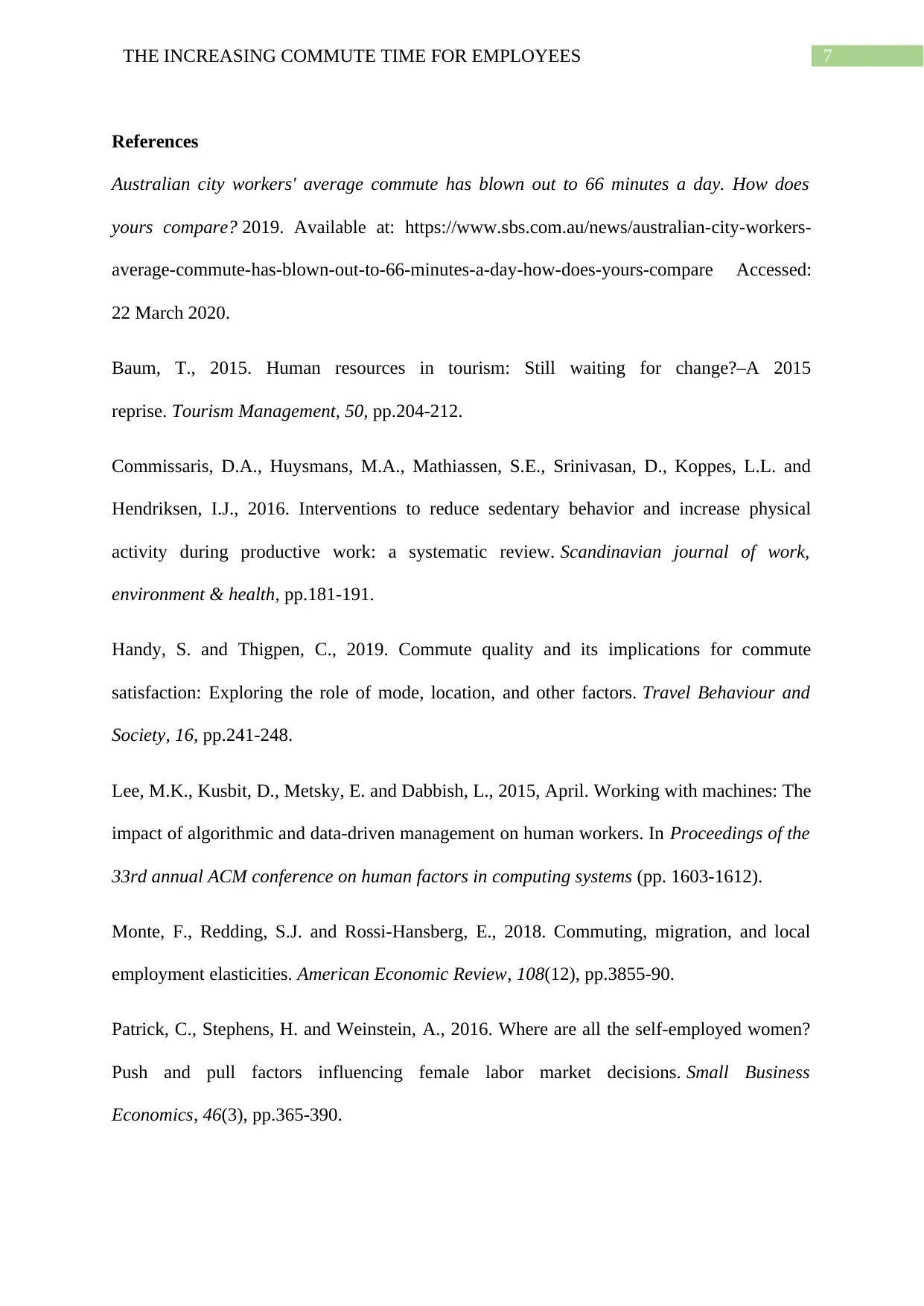
7THE INCREASING COMMUTE TIME FOR EMPLOYEES
References
Australian city workers' average commute has blown out to 66 minutes a day. How does
yours compare? 2019. Available at: https://www.sbs.com.au/news/australian-city-workers-
average-commute-has-blown-out-to-66-minutes-a-day-how-does-yours-compare Accessed:
22 March 2020.
Baum, T., 2015. Human resources in tourism: Still waiting for change?–A 2015
reprise. Tourism Management, 50, pp.204-212.
Commissaris, D.A., Huysmans, M.A., Mathiassen, S.E., Srinivasan, D., Koppes, L.L. and
Hendriksen, I.J., 2016. Interventions to reduce sedentary behavior and increase physical
activity during productive work: a systematic review. Scandinavian journal of work,
environment & health, pp.181-191.
Handy, S. and Thigpen, C., 2019. Commute quality and its implications for commute
satisfaction: Exploring the role of mode, location, and other factors. Travel Behaviour and
Society, 16, pp.241-248.
Lee, M.K., Kusbit, D., Metsky, E. and Dabbish, L., 2015, April. Working with machines: The
impact of algorithmic and data-driven management on human workers. In Proceedings of the
33rd annual ACM conference on human factors in computing systems (pp. 1603-1612).
Monte, F., Redding, S.J. and Rossi-Hansberg, E., 2018. Commuting, migration, and local
employment elasticities. American Economic Review, 108(12), pp.3855-90.
Patrick, C., Stephens, H. and Weinstein, A., 2016. Where are all the self-employed women?
Push and pull factors influencing female labor market decisions. Small Business
Economics, 46(3), pp.365-390.
References
Australian city workers' average commute has blown out to 66 minutes a day. How does
yours compare? 2019. Available at: https://www.sbs.com.au/news/australian-city-workers-
average-commute-has-blown-out-to-66-minutes-a-day-how-does-yours-compare Accessed:
22 March 2020.
Baum, T., 2015. Human resources in tourism: Still waiting for change?–A 2015
reprise. Tourism Management, 50, pp.204-212.
Commissaris, D.A., Huysmans, M.A., Mathiassen, S.E., Srinivasan, D., Koppes, L.L. and
Hendriksen, I.J., 2016. Interventions to reduce sedentary behavior and increase physical
activity during productive work: a systematic review. Scandinavian journal of work,
environment & health, pp.181-191.
Handy, S. and Thigpen, C., 2019. Commute quality and its implications for commute
satisfaction: Exploring the role of mode, location, and other factors. Travel Behaviour and
Society, 16, pp.241-248.
Lee, M.K., Kusbit, D., Metsky, E. and Dabbish, L., 2015, April. Working with machines: The
impact of algorithmic and data-driven management on human workers. In Proceedings of the
33rd annual ACM conference on human factors in computing systems (pp. 1603-1612).
Monte, F., Redding, S.J. and Rossi-Hansberg, E., 2018. Commuting, migration, and local
employment elasticities. American Economic Review, 108(12), pp.3855-90.
Patrick, C., Stephens, H. and Weinstein, A., 2016. Where are all the self-employed women?
Push and pull factors influencing female labor market decisions. Small Business
Economics, 46(3), pp.365-390.
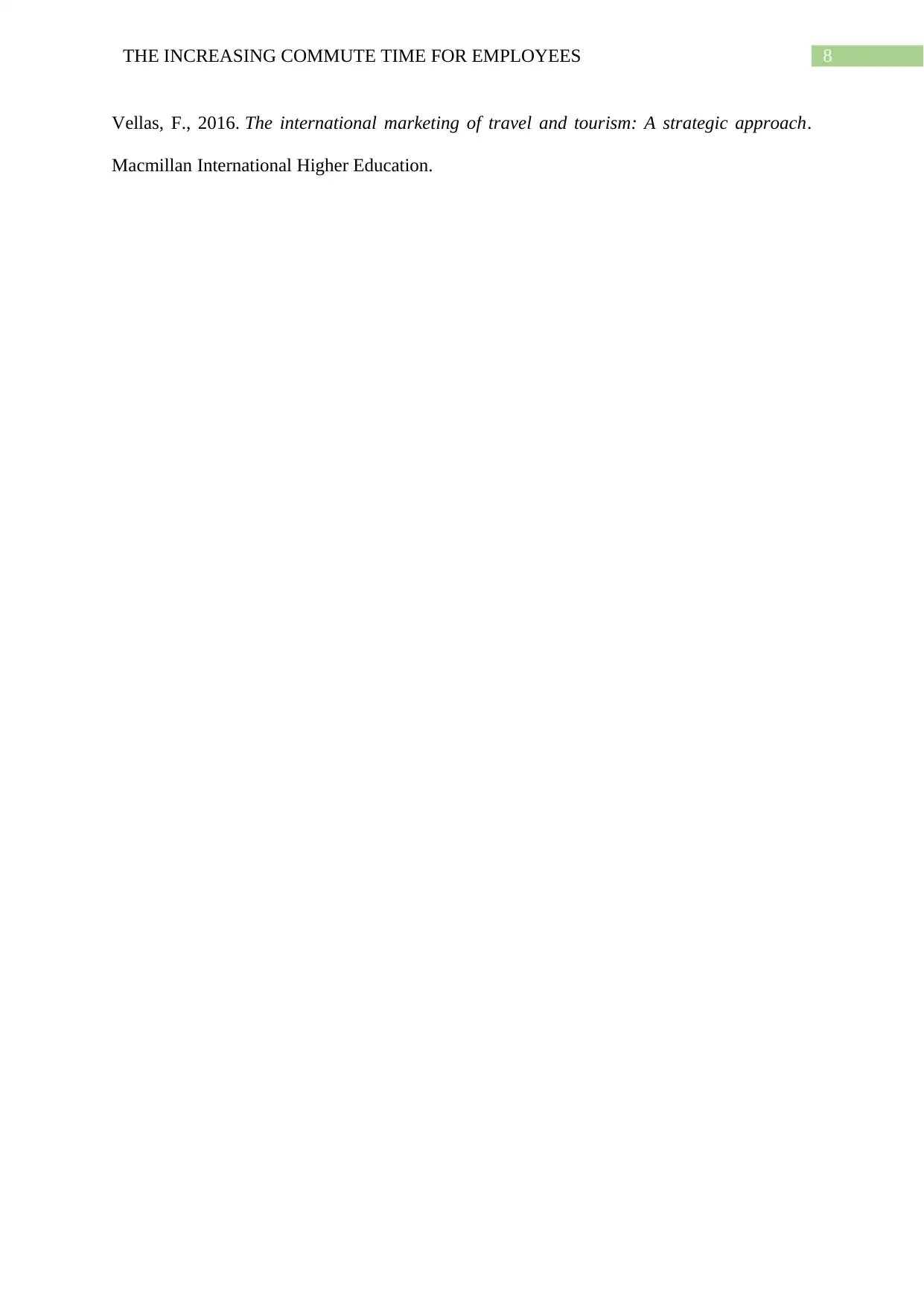
8THE INCREASING COMMUTE TIME FOR EMPLOYEES
Vellas, F., 2016. The international marketing of travel and tourism: A strategic approach.
Macmillan International Higher Education.
Vellas, F., 2016. The international marketing of travel and tourism: A strategic approach.
Macmillan International Higher Education.
⊘ This is a preview!⊘
Do you want full access?
Subscribe today to unlock all pages.

Trusted by 1+ million students worldwide
1 out of 9
Related Documents
Your All-in-One AI-Powered Toolkit for Academic Success.
+13062052269
info@desklib.com
Available 24*7 on WhatsApp / Email
![[object Object]](/_next/static/media/star-bottom.7253800d.svg)
Unlock your academic potential
Copyright © 2020–2025 A2Z Services. All Rights Reserved. Developed and managed by ZUCOL.





